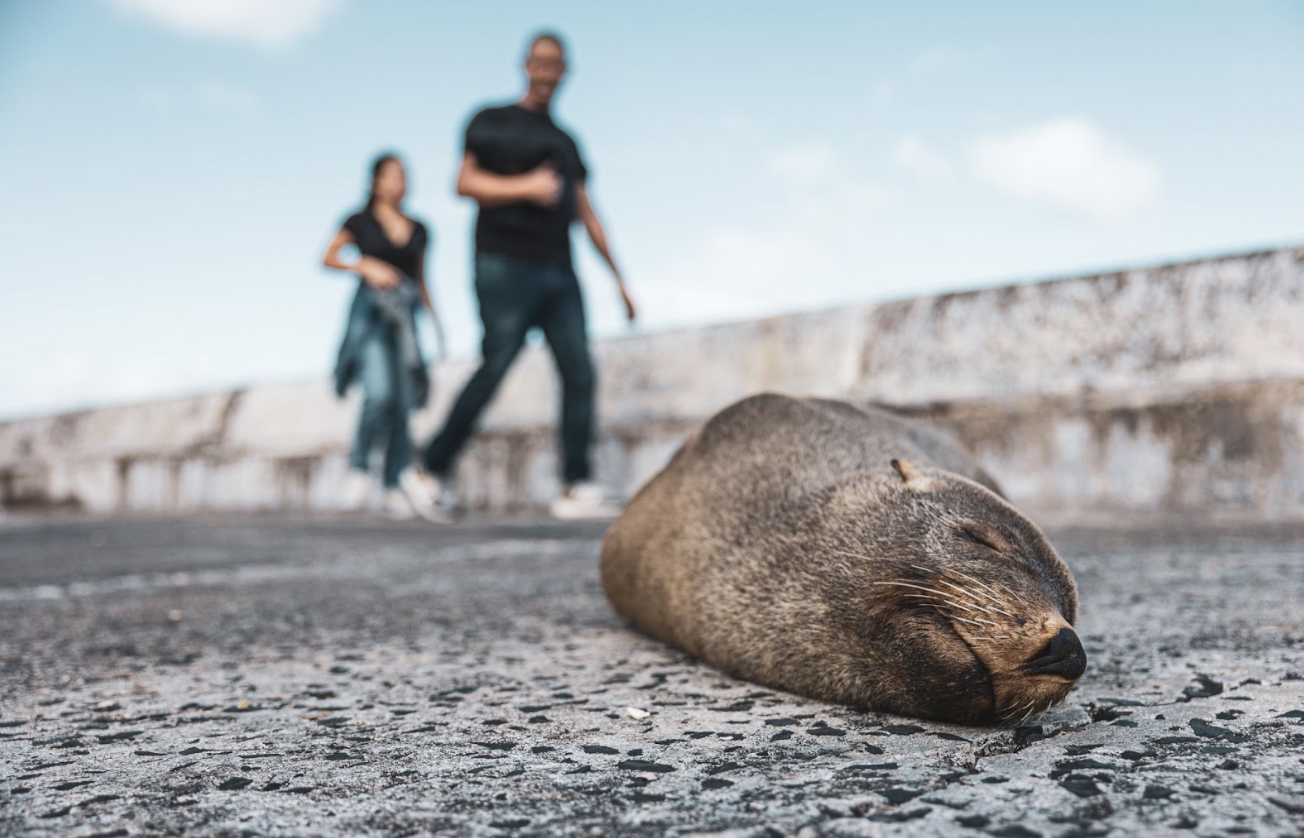For years, Cape fur seals have displayed unusual behaviour — getting unnervingly close to swimmers, chasing scuba divers to the surface, and inflicting severe bite wounds on freedivers. The recent discovery of rabies in seals has sent a shockwave through the ocean-users’ community. Is this the missing puzzle piece that could explain their behavioural change?
Seal health before rabies
Until four years ago, no data on seal health existed, leaving a significant gap in understanding the diseases affecting their populations. Sea Search, a collective of marine mammal scientists, began investigating seal health after observing unusual behaviour and health issues, including increased aggression, pup die-offs, and mass abortions.
 Cape fur seals seen on Seal Island close to Koekenaap on the West Coast in 2020. (Photo: Gallo Images/Nardus Engelbrecht)
Cape fur seals seen on Seal Island close to Koekenaap on the West Coast in 2020. (Photo: Gallo Images/Nardus Engelbrecht)
The population of Cape fur seals ranges between 1,7 and 2,1 million, spanning an approximately 2,800km-long coastline from southern Angola to Plettenberg Bay — a vast stretch of land, often inaccessible to researchers.
Seal mortality is naturally high, with approximately 40% of pups dying in their first year due to various natural causes. Tests revealed significant levels of domoic acid, a neurotoxin, in many seals. This toxin, produced during harmful algal blooms, accumulates in small fish consumed by seals, causing health issues, with one of the symptoms being aggression. It is complicated to predict how these animals suffer and from what, and the recent discovery of rabies adds a new layer of complexity to the seals’ health issues.
Rabies in marine mammals
Rabies is a virus that primarily affects mammals, not birds or reptiles. Its occurrence in marine life is extremely rare. There has been only one confirmed case of a ringed seal in Svalbard, Norway, in 1980 and one seropositive grey seal on the Estonian island of Ösel.
Almost 45 years later, it was found in a Cape fur seal in Cape Town. Up to the present, 17 cases of rabies in seals have been found, and more testing is under way.
Testing, tracing and treating seals
The Western Cape government’s Veterinary Services suggest that it is reasonable to consider rabies endemic in the seal population — meaning the disease is now regularly found in their normal environment.
It is important to note that data and sample collection are difficult. Rabies tests require samples of brain tissue. For these to be tested, a seal had to be noticeably affected. With only a very thin layer of people living along the coastline in Namibia and large areas being off-limits due to mining activities, testing for rabies becomes difficult.
State Veterinarian at the Western Cape Department of Agriculture, Dr Lesley van Helden, says the viruses found in seals are closely related to the rabies viruses carried by wildlife in South Africa. Still, given the lack of samples for comparison, it’s impossible to say precisely where the seals could have been exposed to rabies.
 A male seal being fed by a resident in Kalk Bay harbour. (Photo: Gunnar Oberhosel)
A male seal being fed by a resident in Kalk Bay harbour. (Photo: Gunnar Oberhosel)
Efforts to control the virus through culling are not viable for ethical reasons, and historical efforts have shown it is ineffective. Vaccination remains the only effective method, but is impractical given the large seal population. While oral bait vaccines are used successfully in Europe, this method is unsuitable for seals as they are not scavengers and prefer live prey.
“The upcoming breeding season, which increases territoriality and aggression among seals, is a concern for the potential spread of rabies,” noted researcher Simon Elwen from Sea Search.
Read more: Bored and unstimulated, Charlie the lonely Pretoria zoo elephant to be set free at last
Rabies is a severe disease, primarily spread through dog bites, killing approximately 60,000 people worldwide each year. Although no human cases have been reported to date, at least 72 people in South Africa have been bitten or scratched by Cape fur seals since 2021, including eight who were bitten by seals confirmed to have rabies.
Most people who were bitten were either diving or snorkelling with seals. Rabies is transmitted through the saliva of infected animals, but wearing a thick wetsuit and being in an aquatic environment may help reduce the risk of transmission by diluting the saliva with seawater.
No established guidelines
As there are no established guidelines or case studies on dealing with rabies in a marine environment, scientists, tour operators and city officials gathered last week to discuss the issue. Cape fur seals that regularly come in contact with humans will be vaccinated and those suspected to carry the disease euthanised. Antarctic, leopard, and elephant seals that are infrequently spotted along our coastline will also be vaccinated to prevent further spread of the virus.

If a seal bites you, according to the Western Cape government’s website you should clean the wound and visit a hospital immediately. Rabies vaccination is available, and the disease is preventable with prompt and appropriate medical care.
Living close to nature comes with a price, and the recent outbreak of rabies in seals has reminded us of this truth all too clearly. Rabies is here to stay, and we must navigate this new reality. Our responsibility is to keep each other safe by learning about the disease and facing this challenge together. DM
Thanks to Simon Elwen from Sea Search and Dr Leslie van Helden, Western Cape State Vet, for providing the necessary information for writing this article.
https://www.youtube.com/watch?v=REeWvTRUpMk




 Male seal fed by a resident in Kalk Bay harbour.(Photo: GunnarOberhosel)
Male seal fed by a resident in Kalk Bay harbour.(Photo: GunnarOberhosel) 